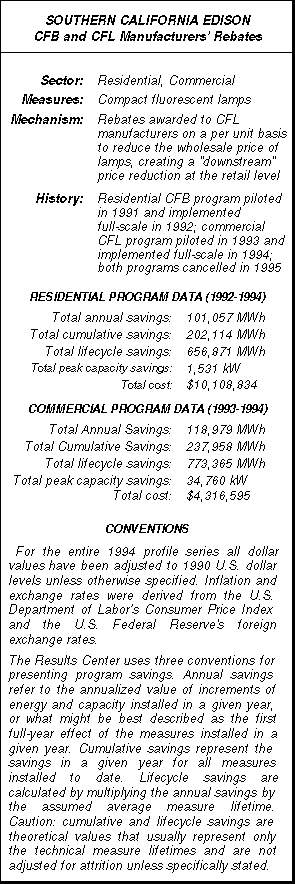IIEC Recent News
Southern California Edison, CFB Manufacturer's Rebate (residential/commercial), Profile #113
EXECUTIVE SUMMARY
 Utilities have learned that moving rebates upstream, from the consumer to the vendor, is a cost-effective means of promoting energy efficiency. Southern California Edison has demonstrated the success of this model in its Compact Fluorescent Bulb program, which gives the incentive to the manufacturer, creating two pronounced benefits. First, by requiring that the manufacturer pass along the unit savings downstream, a $5 incentive becomes far greater when it reaches the consumer. (Consumer discounts can reach as high as $15 with a $5 manufacturer’s rebate.) Second, by allocating wholesale rebates to a large quantity of lamps from manufacturers, utilities can stipulate performance criteria, such as maximum levels of harmonic distortion and minimum efficiency levels. Manufacturers’ rebate programs can create financial leverage while transforming the market for energy-efficient products.
Utilities have learned that moving rebates upstream, from the consumer to the vendor, is a cost-effective means of promoting energy efficiency. Southern California Edison has demonstrated the success of this model in its Compact Fluorescent Bulb program, which gives the incentive to the manufacturer, creating two pronounced benefits. First, by requiring that the manufacturer pass along the unit savings downstream, a $5 incentive becomes far greater when it reaches the consumer. (Consumer discounts can reach as high as $15 with a $5 manufacturer’s rebate.) Second, by allocating wholesale rebates to a large quantity of lamps from manufacturers, utilities can stipulate performance criteria, such as maximum levels of harmonic distortion and minimum efficiency levels. Manufacturers’ rebate programs can create financial leverage while transforming the market for energy-efficient products.
Another feature of the CFB program design is its three-fold ability to work with manufacturers to achieve even greater cost savings and performance improvements, each of which will further stimulate market transformation. First, since the utility rebates CFLs in bulk, manufacturers have been keen to participate in the program, and have even contributed to further lower the cost of the lamps. Second, by establishing a bidding and scoring system, Edison has been able to push manufacturers to produce products with quite specific and improved performance characteristics. Third, the program has been able to reward manufacturers with strong and established distribution channels (for instance, in large retail chains). Edison’s contracts with participating manufacturers included a prerequisite number of units to be sold within an allotted timeframe. If this quota was not met, SCE reallocated the funds to other manufacturers who could deliver, market, and sell the lamps. Points were also awarded to manufacturers based on the degree to which they would commit to help market the lamps, often through cooperative arrangements with retailers.
Included in the program’s design is a self monitoring component which cuts the administrative responsibilities of the utility and obligates the manufacturers to meet sales commitments. Verification of completed sales was required in the form of purchase orders and shipping documentation before manufacturers are reimbursed for their rebates. This confirmed that the pre-set sales agreements had been met and tracked the movement of units for SCE.
SCE’s manufacturer’s rebate program is a proven method of achieving high penetration and market transformation at lower costs in an easily transferable design. Their residential CFB program succeeded in moving over 2 million lamps with administrative costs running only 10% of the program’s total costs, increasing the products’ distribution by eight-fold. A similar success was experienced when SCE applied the model to their commercial customers and to other efficiency technologies. Currently, this same model is being considered by utilities across the country and on a nation-wide scale.
[CLICK HERE TO DOWNLOAD THE ENTIRE 24 PAGE PROFILE IN PDF FILE FORMAT]
This profile was produced by 

